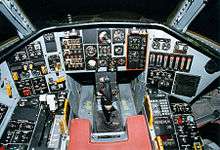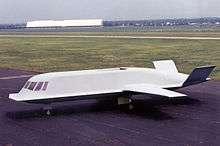Northrop Tacit Blue
The Northrop Tacit Blue was a technology demonstrator aircraft created to demonstrate that a low-observable stealth surveillance aircraft with a low-probability-of-intercept radar (LPIR) and other sensors could operate close to the forward line of battle with a high degree of survivability.
| Tacit Blue | |
|---|---|
 | |
| Role | Stealth demonstrator |
| Manufacturer | Northrop Corporation |
| First flight | February 5, 1982 |
| Retired | 1985 |
| Status | Retired |
| Primary user | United States Air Force |
| Number built | 1 |
Development
Unveiled by the U.S. Air Force on 30 April 1996, the Tacit Blue Technology Demonstration Program was designed to prove that such an aircraft could continuously monitor the ground situation deep behind the battlefield and provide targeting information in real time to a ground command center.
In December 1976, DARPA and the U.S. Air Force initiated the Battlefield Surveillance Aircraft-Experimental (BSAX) program, which was part of a larger Air Force program called Pave Mover. The BSAX program's goal was to develop an efficient stealth reconnaissance aircraft with a low probability of intercept radar and other sensors that could operate close to the forward line of battle with a high degree of survivability.
Tacit Blue represented the "black" component in the larger "Assault Breaker" program, which intended to validate the concept of massed standoff attacks on advancing armoured formations using smart munitions. The Pave Mover radar demonstrators provided the non-stealth portion of the program's targeting system, whereas Tacit Blue was intended to demonstrate a similar but stealth capability, while validating a number of innovative stealth technology advances.[1]
The radar sensor technology developed for Tacit Blue evolved into the radar now being used by the E-8 Joint STARS aircraft.[2]
Design
Tacit Blue, nicknamed "the whale" (and sometimes also called an "alien school bus" for its only slightly rounded-off rectangular shape),[6] featured a straight tapered wing with a V-tail mounted on an oversized fuselage with a curved shape. It was the first stealth aircraft to feature curved surfaces for radar cross-section reduction.[7] Northrop would use this stealth technology on the B-2 bomber. A single flush inlet on the top of the fuselage provided air to two high-bypass turbofan engines. Tacit Blue employed a quadruply redundant digital fly-by-wire flight control system to help stabilize the aircraft about its longitudinal and directional axes.
Operational history

The aircraft made its first successful flight on February 5, 1982, in Area 51, at Groom Lake, Nevada, flown by Northrop test pilot Richard G. Thomas.[5] The aircraft subsequently logged 135 flights over a three-year period. The aircraft often flew three to four flights weekly and several times flew more than once a day.
Another Tacit Blue test pilot, Ken Dyson, told CNN in 2014 that Northrop had manufactured additional major components for the jet, which amounted to half of a second plane. "If we lost one, we could have a second one up and flying in short order," Dyson said.[8]
After reaching about 250 flight hours, the aircraft was placed in storage in 1985. In 1996, after Tacit Blue was declassified, it was placed on display at the National Museum of the United States Air Force at Wright-Patterson Air Force Base, near Dayton, Ohio and has been on display in the new fourth hangar at the museum since June 2016.[9]
Specifications
Data from
General characteristics
- Crew: 1
- Length: 55 ft 10 in (17.02 m)
- Wingspan: 48 ft 2 in (14.68 m)
- Height: 10 ft 7 in (3.23 m)
- Airfoil: Clark Y mod.[10]
- Gross weight: 30,000 lb (13,608 kg)
- Powerplant: 2 × Garrett ATF3-6 turbofan engines, 5,440 lbf (24.2 kN) thrust each
Performance
- Maximum speed: 250 kn (290 mph, 460 km/h)
- Service ceiling: 25,000–30,000 ft (7,600–9,100 m) operating altitude
- Thrust/weight: 0.36
See also
Aircraft of comparable role, configuration and era
Related lists
References
- Assault Breaker Program Analysis.
- Ramon Lopez (8 May 1996). "Out of the black comes Tacit Blue". Flight Global.
- VARTABEDIAN, Ralph (26 February 1993). "Job Stress Catches Up With 'Dr. Stealth' of Aerospace : Science: Eccentric genius John Cashen's departure for Australia has many questioning the technology's future". L A Times. Retrieved 28 August 2018.
- "Tacit Blue". Photos: A brief history of stealth aircraft. C/Net news. November 23, 2007. Archived from the original on September 7, 2012. Retrieved 2 May 2012.
- Grier, Peter (August 1996). "The (Tacit) Blue Whale". Air Force Magazine. Retrieved 25 August 2018.
- "Lockheed's Senior Peg: The Forgotten Stealth Bomber".
- Merlin, Peter W. (2011). Area 51. Arcadia Publishing. p. 119. ISBN 0738576204.CS1 maint: ref=harv (link)
- Patterson, Thom (February 2014). "Area 51 Spy Plane and Other Aviation Tales". CNN. Retrieved 25 June 2020.
- National Museum of the USAF Fact Sheet
- Lednicer, David. "The Incomplete Guide to Airfoil Usage". m-selig.ae.illinois.edu. Retrieved 16 April 2019.
External links
| Wikimedia Commons has media related to Northrop Tacit Blue. |
